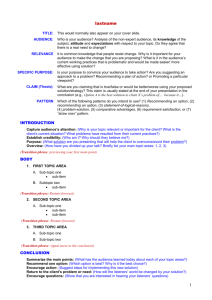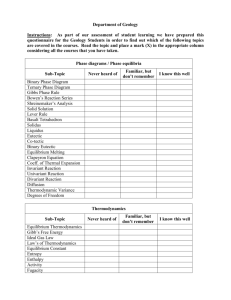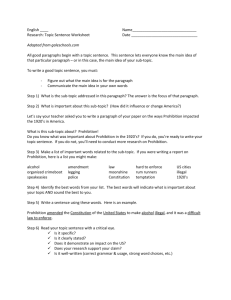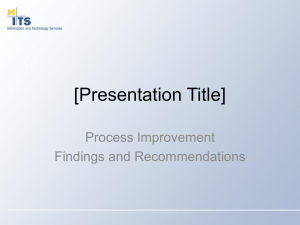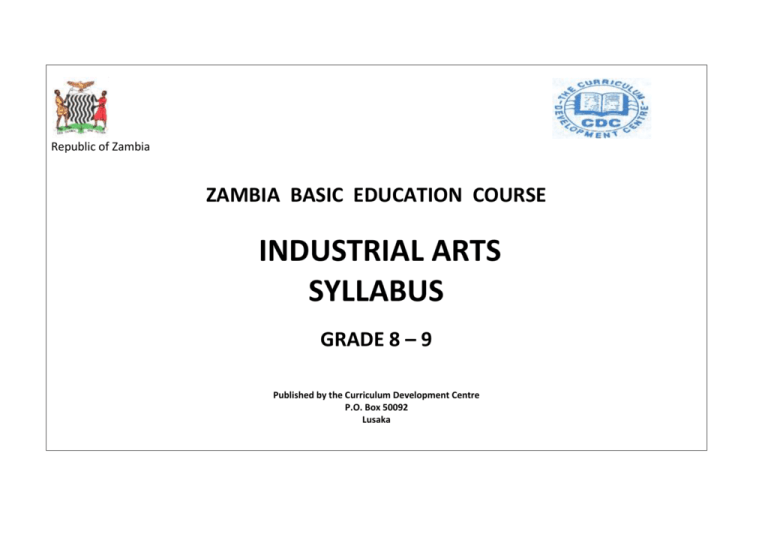
Republic of Zambia
ZAMBIA BASIC EDUCATION COURSE
INDUSTRIAL ARTS
SYLLABUS
GRADE 8 – 9
Published by the Curriculum Development Centre
P.O. Box 50092
Lusaka
ZAMBIA BASIC EDUCATION COURSE
INDUSTRIAL ARTS
SYLLABUS
GRADE 8 – 9
Published by the Curriculum Development Centre
P.O. Box 50092
Lusaka
(c)
1997 Curriculum Development Centre
All rights Reserved. No parts of this publication may be produced, stored in a retrieval or transmitted in any form by any means, electronic,
mechanical, photocopying recording or otherwise without the prior permission of the copyright owner.
TABLE OF CONTENTS
Page
Preface......................................................................................................................................................................................................
Acknowledgements..................................................................................................................................................................................
Introduction...............................................................................................................................................................................................
General Aims............................................................................................................................................................................................
Terminal Objectives .....................................................................................................................................................................................
Specific Aims.................................................................................................................................................................................................
Outline of the Syllabus................................................................ .................................................................................................................
Safety...................................... .....................................................................................................................................................................
Technical drawing Grade 8...........................................................................................................................................................................
Technical Drawing Grade 9..........................................................................................................................................................................
Woodwork Grade 8......................................................................................................................................................................................
Woodwork Grade 9......................................................................................................................................................................................
Metalwork Grade 8.......................................................................................................................................................................................
Metalwork Grade 9........................................................................................................................................................................................
Building Crafts Grade 8 -9.............................................................................................................................................................................
Assessment Procedure.............................................................. ......................................................................................................................
i
ii
iii
iv
v
vi
vii
1
3
10
13
21
24
33
38
42
PREFACE
i
This syllabus was produced as a result of the launched Symposium in 1993addressed matters pertaining to the coverage in the curriculum of life
skills including reasoning and problem solving. The primary school Curriculum review exercise was carried out by the Ministry of Education
under the auspices of the Curriculum Development Centre (CDC) between July and August, 1995. The subjects included in the review were:
Physical Education, Industrial Arts, Art and Design, Music land Spiritual and Moral Education (Religious Education) of which a new syllabus
was subsequently produced for each one of them.
The review was necessitated by the need to improve the quality of education provided at basic level. The improvements required in the
curriculum were also defined and recommended in Focus on Learning (1992) that included life skills. Subsequently workshops were conducted
to review the old syllabuses and a series of in house activities were held at CDC in which the amendments were made to the syllabuses.
The review exercise also considered several issues of national concern which could not be taught as separate subjects, due to the large number of
subjects in the Curriculum. These included Human Rights and Democracy, Gender Issues, Population Education, Environmental Education,
Health Education and HIV/AIDS Education. They were addressed as integral parts of the relevant existing subjects in the curriculum.
It is my sincere hope that this revised syllabus will improve learning and teaching of music in schools.
Sichalwe M. Kasanda (Dr.)
PERMANENT SECRETARY
MINISTRY OF EDUCATION.
ACKNOWLEDGEMENTS
ii
The primary curriculum review exercise would not have been accomplished without the involvement, participation and commitment of many
people. We want to thank all them. Most importantly we must thank Zambia Education Rehabilitation Programme for financing the exercise.
Secondly, we wish to thank you all the people, Government departments, institutions of learning, Non-Governmental Organisational and Donor
Agencies who, in many varied ways, contributed towards the production of this syllabus. These include all those who found time or were able to
allow their staff to attend the launching symposium during which time CDC staff obtained useful information for the review process.
We want to mention in particular Professor M.J. Kelly (UNZA), Professor, M. Kashoki (UNZA), Dr. S.D. Kasanda (PS_MOE), Miss J. Chileshe
(Zambia Environmental Education Project), Mr. N. Phiri (Ministry of Health), Fr. Flynn (UNZA), Mrs. M. Mwansa (Drug Enforcement
Commission) for preparing and presenting papers on various themes.
We are greatly indebted to the following people who participated in the revision workshop.
1.
2.
3.
4.
5.
6.
Mr. R.S. Kaulule, Senior Inspector – Industrial Arts (Ministry of Education), Lusaka
Mr. J.B. Nkole, Senior Curriculum Specialist – Industrial Arts (CDC), Lusaka
Mr. J.S. Muyangana, Curriculum Development Officer – Industrial Arts, (CDC), Lusaka
Mr. M.W.P. Mwale, Head of Department – Industrial Arts, Kabulonga Secondary School, Lusaka
Mr. F.C. Singoyi, Industrial Arts Teacher, Kamwala Secondary School, Lusaka
Ms. S.M. Musonda, Industrial Arts Teacher, St. Patricks Girls’ School, Lusaka
Finally, we wish to acknowledge our indebtedness to the late Dr. Mkangaza formerly Director of Curriculum Development Centre, for his
valuable contributions in guiding the review exercise.
E.F. Chingo (Mrs.)
DIRECTOR
CURRICULUM DEVELOPMENT CENTRE
MINISTRY OF EDUCATION
iii
1.0
INTRODUCTION
The teaching of craft, design and technology incorporates: woodwork, metalwork, building craft, technical drawing, maintenance and repairs. These
activities should be offered from grade 8 – 9. Although the syllabus is divided into separate areas may be combined or integrated when making
certain project items in any of the subject areas e.g. building a house, making or producing a machete, a knife, axe, etc etc. In our situation the
allocated time to each class in three consecutive periods of 40 minutes each. The schemes of work which could be both termly or yearly should be
based on the availability of materials
Attempts should be made to employ all methods of crafts, design and technology as may be determined by workshop facilities, tools, materials and
the learner. Craft, design and technology should be integrated with other school subjects. Skills learnt during lessons can serve other subjects and the
production work. This makes craft design and technology more valuable and meaningful.
Information concerning teaching of different skills, physical resources, planning of schemes, planning of work, teaching methods and evaluation,
should be found in the teachers handbook.
iv
2.0
GENERAL AIMS
By the end of the Basic Education Course, pupils should be able to:-
2.1
Master the general skills of craft, design and technology which apply to the problems of everyday life.
2.2
Recognise modern and local materials, working processes and technology used in producing various useful items.
2.3
Master correct working habits and safety precautions.
2.4
Appreciate the value of craft, design and technology.
2.5
Put the natural resources of the country to good use.
2.6
Achieve a level of skills in craft, design and technology necessary for further technical and vocational training.
2.7
Value the importance of fostering and transmitting the Zambian Cultural heritage.
v
TERMINAL OBJECTIVES
Craft, design and technology tuition, pupils should be able to:
3.0
Explain about the aesthetic and environmental implications of craft, design and technology and technology teaching in order to make wise decisions
and choices.
3.1
Acquire skills and practical or technical knowledge from their environmental and the literature available.
3.2
Learn how to make functional, marketable and decorative items.
3.3
acquaint themselves with improvising through the use of natural and artificial materials.
3.4
Have a positive attitude towards manual work.
4.0
OUTLINE OF THE SYLLABUS
The above sections have outlined the general aims Terminal Objectives of the syllabus in terms of levels of concepts, knowledge, attitude and skills. The
purpose of this section is to outline the objectives to be achieved. The main topic, sub-topic and objectives are arranged in that order for ease of reference.
Topics may be similar in all grades but the level of knowledge, skills concepts and attitudes to be attained are also graded accordingly. Safety is shown first
because it applies to all crafts, design and technology activities.
1.
SAFETY: GRADES 8 – 9
MAIN TOPIC
SUB-TOPIC
SPECIFIC OBJECTIVES: PSBAT
1.0
1.1.
1.1.2 name the dangerous objects in the
environment.
1.1.3 use safety Equipment correctly.
1.1.4 list the precautional measures.
1.1.5 observe Safety regulations
1.1.6 take safety precautions
SAFETY
Safety
Precautions
1.2. Storage of Tools
And materials.
1.2.1 identify tools and materials.
1.2.2 apply correct storage methods for tools and
materials.
1.2.3 assess storage of tools and materials.
1.3. Protective Clothing
1.3.1
1.3.2
1.3.3
1.3.4
identify safety clothing.
name safety clothing
use safety clothing
maintain and care for safety clothing.
1.4. Care for nature
1.4.1 discuss the importance of living and nonliving things to mankind.
1.4.2 discuss nature
1.4.3 value and appreciate nature
2
SAFETY: GRADES 8 - 9
MAIN TOPIC
SUB-TOPIC
SPECIFIC OBJECTIVES: PSBAT
1.5
1.5.1 identify pollution in their environment.
Pollution
1.5.2
discuss pollution.
1.5.3 live in a clean environment
1.6
First Aid
1.6.1 apply basic first aid.
1.6.2 observe correct attitudes towards injuries.
1.6.3 apply first aid in their daily operations.
3
TECHNICAL DRAWING: GRADE 8
MAIN TOPIC
SUB-TOPIC
SPECIFIC OBJECTIVES: PSBAT
1.0
USE OF INSTRUMENTS
1.1
Drawing instruments:
1.1.1 identify drawing instruments.
1.1.2 discuss the correct use of instruments.
1.1.3 use the instruments correctly.
1.1.4 care and maintain the instruments.
2.0.
LETTERING
2.1
Upright and sloping
2.1.1 print upright or slating capital letters
Properly
3.0.
LAYOUT OF PAPER
3.1
Border line 10mm (BS 308, 1985)
3.1.1 draw the title block standard BS 308, 1985.
3.2
Title block and lettering data.
3.2.1 draw the title block.
3.2.2
print information in the title block.
3.2.3
assess their own completed work
4
MAIN TOPIC
SUB-TOPIC
SPECIFIC OBJECTIVES: PSBAT
4.0. STRAIGHT LINE CONSTRUCTION
4.1
Bisection
4.1.1
Bisect a given line
4.2.
Perpendiculars
4.2.1
construct perpendiculars to and from a
given point
4.3.
Parallel lines
4.3.1
4.4.
Division of s straight line into square
parts
Construct a line parallel to compass and
Square
4.4.1
divide a line into equal and proportional
parts (ratio)
4.4.2
master the techniques of construction.
5.1. Types of angles
5.1.1
name different types of angles.
5.2.
5.2.1
construct various angles and combinations.
5.0.
CONSTRUCTION
Construction of different Angles
5
MAIN TOPIC
6.0
TRIANGLES
SUB-TOPIC
SPECIFIC OBJECTIVES: PSBAT
5.3.
Bisection
5.3.1
bisect
5.4.
Copying
5.4.1
copy angles
5.4.2
bisect angles
5.4.3
relate the construction of angles to their
daily workshop experience.
6.1.1
identify internal and external angles.
6.1.2
determine properties of internal and
external angles
6.1.3
identify the various triangles
6.1.4
name the various triangles
6.1.5
construct the various triangles from given
data.
6.1.6
construct similar triangles
6.1.7
construct congruent triangles.
6.1.8
apply the construction in planning and
designing.
6.1 Internal and external construction of
triangles from given data
6
MAIN TOPIC
SUB-TOPIC
SPECIFIC OBJECTIVES: PSBAT
7.0. CIRCLES
7.1.
7.1.1
identify chord, arcs, circumference.
7.1.2
use chord, arcs circumference in
Parts of a circle
geometrical constructions and
designing.
7.2. Angles in semi-circle
7.3.
Circumscribing, inscribing and escribing
plain figures
7.2.1 identify different angles.
7.2.2
determine properties of the circle.
7.3.1
circumscribe lain figures
7.3.2 inscribe plain figures
7.3.3
escribe plain figures
7.3.4
use the techniques in their planning and
designing.
7.3.5
assess their own work
7
TECHNICAL DRAWING: GRADE 8
MAIN TOPIC
SUB-TOPIC
SPECIFIC OBJECTIVES: PSBAT
8.0.
8.1
8.1.1
identify an ellipse
8.1.2
recall various methods of constructing an
ELLIPSE
Construction of an Ellipse
ellipse.
8.1.3
construct an ellipse using the
recommended methods
8.1.4
apply the technique of drawing in their
planning and design.
8.1.5
use ellipse in construction
8
TECHNICAL DRAWING : GRADE 8
MAIN TOPIC
SUB-TOPIC
SPECIFIC OBJECTIVES: PSBAT
9.0.
9.1
9.1.1
construct a tangent from a point on the
circumference of a circle.
9.1.2
construct a tangent from a point on the
circumference of a circle.
9.1.3
discuss the importance of tangents.
TANGENTS AND
ANGENTIAL ARCS
Construction of a tangent
9.2 Common internal and external tangents
9.3 Radius corners and Right Angles, Acute
Angles and Obtuse Angles
9.2.1 identify and name internal and external
tangents.
9.2.2
construct internal tangents.
9.3.1
Construct radius corners at acute angles
and obtuse.
master the techniques of construction.
9.3.2
9.3.3
apply the techniques gained on more
drawings.
9
TECHNICAL DRAWING : GRADE 8
MAIN TOPIC
SUB-TOPIC
SPECIFIC OBJECTIVES: PSBAT
10.0
10.1 Properties and construction of triangles
10.1.1 identify and name the polygons.
PENTAGONS
10.1.2
construct rectangles, squares, pentagons,
hexagons and octagons from given data.
10.1.3
apply techniques in their planning and
designing.
10
TECHNICAL DRAWING : GRADE 9
MAIN TOPIC
SUB-TOPIC
SPECIFIC OBJECTIVES: PSBAT
1.0 PROJECTION OF SOLIDS
1.1 Orthographic projection
1.1.1
draw the three views of:
Prism, pyramids, cylinders, cones.
1.1.2
differentiate various types of solids
geometrically.
1.1.3
adopt one angle of projection.
1.1.4
assess their own work.
2.0 ISOMETRIC PROJECTION
2.1 Simple objects models incorporating
circles and arcs compass method
ordinate/free hand method.
2.1.1 identify various methods of construction
arcs and circles in Isometric projection.
2.1.2
draw Isometric circles and arcs involved
in models.
2.1.3
master the methods of constructing
Isometric circles and arcs
11
TECHNICAL DRAWING: GRADE 9
MAIN TOPIC
SUB-TOPIC
SPECIFIC OBJECTIVES: PSBAT
3.0
3.1 Hollow Boxes
3.1.1
Define ‘development’
3.1.2
draw development of hollow boxes.
3.2. Prisms
3.2.1
draw developments of prisms
3.3 Cylinders
3.3.1
draw developments of cylinders.
3.3.2
apply the techniques of development in
their practical metal work.
4.0
DEVELOPMENT
FREE HAND SKETCHING
4.1 Isometric freehand to orthographic
drawing
4.1.1 interprete correctly orthographic view to
pictorial.
4.1.2
draw Isometric freehand pictorial view of
objects from orthographic view in proper
proportion.
4.1.3
assess their own work.
4.1.4
relate their acquired skill into their daily
workshop experiences.
12
TECHNICAL DRAWING: GRADE 9
MAIN TOPIC
SUB-TOPIC
SPECIFIC OBJECTIVES: PSBAT
5.0
5.1
First angle projection of simple machine
5.1.1
identify 1st and 3rd angle projection
5.2
Third angle projection of simple parts
5.2.1
interprete machine drawings correctly
5.2.2
draw views of simple machine parts in both
angles correctly.
5.3.1
define ‘sectioning’
ORTHOGRAPHIC PROJECTION
5.3
Vertical and horizontal sectioning
5.3.2 identify webs, holes, channels, slots on
simple machine parts correctly.
5.3.3
represent webs, holes, channels and view
of simple machine parts correctly.
5.3.4
judge and assess their won work
13
WOODWORK: GRADE 8
MAIN TOPIC
SUB-TOPIC
SPECIFIC OBJECTIVES: PSBAT
9.0
1.1
1.1.1
recall the workshop routine
1.1.2
demonstrate the workshop routine by
showing orderly behaviour.
1.2.1
recall discipline and safety precautions.
1.2.2
demonstrate disciplined and safety
behaviour.
1.3.1
identify hand and power tools and
equipment.
1.3.2
locate hand power tools and equipment in
the workshop.
1.3.3
demonstrate proper storage of tools and
equipment.
1.3.4
care for their workshop tools and
equipment.
INTRODUCTION
TO THE WORKSHOP
1.2.
1.3
Workshop routine
Discipline of hand and safety precautions
Identification of hand and power tools
and equipment
14
WOODWORK: GRADE 8
MAIN TOPIC
SUB-TOPIC
SPECIFIC OBJECTIVES: PSBAT
2.0
2.1
2.1.1
identify and name the saws.
2.1.2
describe and explain the uses of saws.
2.1.3
draw and label the parts of saws.
2.1.4
classify saws according to the number of
teeth.
2.1.5
realise the importance of setting a saw.
2.1.6
care for the saws properly.
SAWING
Types of saws
15
WOODWORK: GRADE 8
MAIN TOPIC
3.0. PLANING
SUB-TOPIC
SPECIFIC OBJECTIVES: PSBAT
2.2
2.2.1
describe techniques of sawing using
trestles.
2.2.2
demonstrate sawing on trestles.
2.2.3
identify and name sawing boards.
2.2.4
hold a work piece using a bench hook to
saw.
2.2.5
use a mitre box to saw mitres accurately.
2.2.6
discuss different techniques of sawing.
2.2.7
saw accurately using a copying and bows
saws.
2.2.8
master the skill of sawing
3.1.1
identify and name the planes.
3.1.2
label the parts of a plane
3.1.3
describe and explain the uses of the
planes.
3.1.4
explain the function of the parts on the
plane.
Sawing techniques
3.1. Types of planes
16
WOODWORK: GRADE 8
MAIN TOPIC
SUB-TOPIC
SPECIFIC OBJECTIVES: PSBAT
4.0
4.1 Types and uses of chisels and gouges.
4.1.1
identify and name chisels and gouges.
4.1.2
sketch and label parts of chisels and
gouges.
4.1.3
describe different types of chisels.
4.1.4
explain various uses of chisels and gouges.
CHISELLING AND GOUNGING
4.2
Techniques of chiselling and gouging
4.2.1 list of chiselling and gouging.
4.2.2 name types of chiselling and gouging.
4.2.3 Select correct chisels of gouges for the
work at hand.
4.2.4 demonstrate correct methods of chiselling
and gouging.
4.2.5 apply appropriate techniques in chiselling
and gouging.
4.2.6
assess their own work.
17
WOODWORK:GRADE 8
MAIN TOPIC
SUB-TOPIC
SPECIFIC OBJECTIVES: PSBAT
5.1 Types of Nails
5.1.1 identify and name different types of nails
5.1.2 explain the uses of different types of nails
5.1.3 use different nails appropriately.
5.2
Types of Screws
5.2.1 identify and name different types of screw.
5.2.2
explain the uses of the screws.
5.2.3
sketch and label the parts of screws.
5.2.4
use the screw correctly.
18
WOODWORK GRADE 8
MAIN TOPIC
SUB-TOPIC
SPECIFIC OBJECTIVES: PSBAT
6.0
6.1
6.1.1 identify different types of joints.
JOINTING
6.2
Types of Joints
Joinery techniques
6.1.2
name the different types of joints.
6.1.3
explain different uses of joints.
6.1.4
describe types of joints
6.1.5
compare and constrast different types of
joints
6.2.1
identify different bonding materials.
6.2.2
demonstrate correct methods for making
joints.
6.2.3
demonstrate correct methods of fitting
joints with bonding materials.
6.2.4
master the techniques of making the
various joints.
19
WOODWORK: GRADE 8
MAIN TOPIC
SUB-TOPIC
SPECIFIC OBJECTIVES: PSBAT
7.0
7.1
7.1.1
identify the different types of glues.
7.1.2
name the various glues.
7.1.3
select correct glue
7.1.4
demonstrate the correct gluing procedure.
7.1.5
glue according to instructions.
8.1.1
name different tools and materials for
finishing.
8.1.2
discuss the uses of the tools and materials
for finishing.
8.1.3
explain the use of abrasives and finishes
8.0
GLUEING
FINISHING
8.1
Types of glue
Tools and Materials for Finishing.
20
WOODWORK: GRADE 8
MAIN TOPIC
SUB-TOPIC
SPECIFIC OBJECTIVES: PSBAT
8.2
8.2.1 list techniques of finishing.
Finishing Techniques
8.2.2
select appropriate abrasives and finishing
tools.
8.2.3
demonstrate correct methods of using
abrasives and finishing tools.
8.2.4
apply appropriate techniques in using
finishing materials.
8.2.5 judge the quality of finishing.
21
WOODWORK: GRADE 9
MAIN TOPIC
SUB-TOPIC
SPECIFIC OBJECTIVES: PSBAT
1.0
1.1 Boring and Drilling Tools
1.1.1 identify boring and drilling tools.
BORING AND DRILLING
1.2 Boring and Drilling with power drills
2.0
CABINET FITTINGS
2.1 Fastening devices
1.1.2
name boring and drilling tools
1.1.3
classify boring and drilling tools
1.1.4
name parts of drilling and boring tools
1.1.5
assemble parts of boring and drilling
1.1.6
use boring and drilling tools.
1.2.1
use a power drill safely.
1.2.2
select the right speed for the work at hand
1.2.3
bore or drill holes on wood accurately.
1.2.4
compare and constrast their uses
2.1.1
name different types of fasteners.
2.1.2
use different types of fastening devices
22
WOODWORK: GRADE 9
MAIN TOPIC
3.0
WOODS
SUB-TOPIC
SPECIFIC OBJECTIVES: PSBAT
2.2
2.2.1
select appropriate fittings for the job.
2.2.2
discuss the uses of cabinet fittings.
2.2.3
apply correct methods of fittings
3.1.1
discuss the value of trees to mankind
3.1.2
identify local and axotic soft and hard
woods.
3.2.1
explain the growth of timber
3.2.2
describe the different parts of a tree
3.2.3
explain the functions of each part of a tree.
3.3.1
define conservation of timber
3.3.2
explain how logs are sawn into timber
3.3.3
discuss the qualities of converted timber
3.1
3.2
3.3
Cabinet fittings
Types of timber
Growth and structure of timber
Conversion of timber
23
WOODWORK: GRADE 9
MAIN TOPIC
SUB-TOPIC
SPECIFIC OBJECTIVES: PSBAT
3.4.
3.4.1
explain the advantages of seasoning
timber.
3.4.2
explain the two methods of seasoning
timber.
3.43
discuss the difference between air
seasoned and kiln seasoned timber.
Seasoning of timber
3.5 Defects in timber
3.5.1
identify different types of defects in timber
3.5.2
classify defects into artificial and natural
types.
3.5.3
discuss some causes of timber defects and
select the right timber for the job.
24
METALWORK: GRADE 8
MAIN TOPIC
SUB-TOPIC
SPECIFIC OBJECTIVES: PSBAT
1.0
1.1
1.1.1
define ‘Ferrous Metals’
1.1.2
discuss the production of ferrous metals
1.1.3
explain the value of carbon in steel
Production.
1.1.4
use Ferrous Metals
1.2.1
define ‘Non-Ferrous Metals.
1.2.2
identify Non-Ferrous Metals.
1.2.3
discuss important uses of Non-Ferrous
Metals.
1.2.4
use Non-Ferrous Metals.
1.3.1
identify copper alloys.
1.3.2
explain how alloys are made.
1.3.3
discuss various uses of copper alloys.
MATERIALS
Ferrous Metal:
1.2 Non-Ferrous Metals:
1.3
Alloys:
25
METALWORK: GRADE 8
MAIN TOPIC
SUB-TOPIC
SPECIFIC OBJECTIVES: PSBAT
2.0
2.1
2.1.1
recall the basic marking out tools
2.1.2
name basic marking out tools
MARKING OUT
Marking out tools:
2.1.3 label parts of some basic marking out tools.
2.2
Elementary marking out processes:
2.1.4
explain their uses
2.1.5
care for the marking out tools
2.2.1
mark out lines according to instructions.
2.2.2
use elementary marking out processes
correctly.
2.2.3 appreciate their own work.
3.0
FILING
3.1
Types of files and their cross sections:
3.1.1 recall files used in metal work.
3.1.2
classify files by shape and cross section
3.1.3 discuss the different uses of files.
3.1.4 use different files according to instructions
correctly.
26
METAL WORK: GRADE 8
MAIN TOPIC
4.0. SAWING
SUB-TOPIC
SPECIFIC OBJECTIVES: PSBAT
3.2.
3.2.1
care of files
3.2.2
clean files using a file card
3.2.3
design and make storage racks for files
4.1.
Care of files:
Saws:
4.1.1 identify metal-cutting saws
4.1.2
discuss the uses of different saws.
4.1.3 label the different parts of a saw
4.2.
Sawing techniques
4.1.4
select appropriate blades for the job.
4.1.5
fit the blade to the frame and tension it
Correctly
4.1.6
care and maintain the saw.
4.2.1
saw accurately
4.2.2
demonstrate mastery in sawing different
metal materials.
4.2.3
Select the appropriate sawing methods for
the job.
4.2.4
assess the accuracy of sawn work
27
METALWORK: GRADE 8
MAIN TOPIC
SUB-TOPIC
SPECIFIC OBJECTIVES: PSBAT
5.0.
5.1
5.1.1
name different types of tools used for
cutting sheet metal.
5.1.2
discuss the various parts of the tools.
CUTTING SHEET METAL
Types of tools for cutting sheet metal
5.1.3 label parts of sheet metal cutting tools
5.2.
6.1
Uses of cutting tools
Tools and Equipment
5.1.4
care for cutting tools.
5.2.1
discuss various uses of the tinsnips
5.2.2
explain how a bench shears work
5.2.3
use cutting tools correctly.
6.1.1
recall the hand drill and its uses
6.1.2 identify the breast and electric hand drills
.
6.1.3 draw and label the various parts of these
drills.
6.1.4
discuss the different uses of the drilling
tools and equipment.
28
METAL WORK : GRADE 8
MAIN TOPIC
SUB-TOPIC
SPECIFIC OBJECTIVES: PSBAT
6.2
6.2.1
classify drill bits according to their sizes,
types of shank and length.
6.2.2
select the right twist drill bits for the job.
6.2.3
draw and label the parts of a twist bit.
6.3.1
define drilling
6.3.2
explain the processes of drilling
6.3.3
drill according to instructions
6.3.4
hold work safely when drilling
Twist Drill Bits
6.3. Drilling Techniques
6.4.1 identify and name a drilling machine
6.4.2
dress appropriately when drilling
6.4.3
draw and label parts of drilling machines
6.4.4
discuss the functions of the drilling
machines.
6.4.5
operate a drilling machine
6.4.6
care for a drilling machine.
29
METAL WORK : GRADE 8
MAIN TOPIC
SUB-TOPIC
SPECIFIC OBJECTIVES: PSBAT
7.0
7.1
7.1.1
identify tools used in folding and bending.
7.1.2
name the tools used in bending and
folding.
7.1.3
draw and label parts of bending and
folding tools.
7.1.4
discuss the tools used in bending and
folding.
7.1.5
care for Bending and folding tools.
BENDING AND FOLDING
Bending and folding tools
30
METAL WORK: GRADE 8
MAIN TOPIC
SUB-TOPIC
SPECIFIC OBJECTIVES: PSBAT
7.2
7.2.1 identify the types of bending and folding
tools.
Bending and folding techniques:
7.2.2
discuss various bending and folding
techniques.
7.2.3
select correct tools and equipment for
bending.
7.2.4
make the wired rims.
7.2.5
apply correct techniques in bending and
folding materials.
7.2.6
evaluate the completed projects.
31
METAL WORK: GRADE 8
MAIN TOPIC
SUB-TOPIC
SPECIFIC OBJECTIVES: PSBAT
8.0
8.1
8.1.1
recall and identify the tools and materials
used in riveting.
8.1.2
discuss tools and materials used in riveting.
8.1.3
use the riveting tools and materials
correctly.
8.2.1
practice the riveting methods.
8.2.2
rivet correctly.
8.2.3
differentiate the riveting methods.
8.2.4
assess methods of riveting.
9.1.1
recall the straight and the hatchet soldering
bits.
9.1.2
define soft soldering.
RIVETING
8.2
9.0 SOFT SOLDERING
Riveting tools and materials
Uses of cutting tools
9.1. Soldering Equipment and materials
9.1.3 identify the electrical soldering iron.
9.1.4
discuss the uses of soldering equipment
and materials.
9.1.5
use different types of soft soldering tools
and materials correctly.
32
METAL WORK: GRADE 8
MAIN TOPIC
SUB-TOPIC
SPECIFIC OBJECTIVES: PSBAT
9.2
9.2.1
discuss the soft soldering process.
9.2.2
select appropriate methods for the job.
9.2.3
apply soft soldering
Soldering process:
33
METAL WORK GRADE 9
MAIN TOPIC
SUB-TOPIC
SPECIFIC OBJECTIVES: PSBAT
1.0
1.1 Screw Threading Tools
1.1.1 identify tools for hand screw cutting.
SCREW THREADING
1.1.2
classify the tools correctly.
1.1.3 label parts of the tools for hand screw
cutting.
1.2 Types of thread forms
1.1.4
use thread cutting tools correctly.
1.1.5
care for threading tools.
1.2.1 identify isometric threads
1.2.2 label parts of a screw thread.
2.0
FORGE WORK
2.1
Tools for forge work
1.2.3
define external and internal threads.
1.2.4
cut external and internal threads accurately.
1.2.5
classify bolts, nuts and screws according to
uses.
2.1.1
recall tools used in forge work.
2.1.2 identify and name tools used in forge work.
2.1.3
2.1.4
2.1.5
explain the uses of tools in forge work.
sketch and label the tools.
care for the tools.
34
METAL WORK: GRADE 9
MAIN TOPIC
3.0
HEAT TREATMENT OF STEELS.
SUB-TOPIC
SPECIFIC OBJECTIVES: PSBAT
2.2
2.2.1
2.2.2
2.2.3
2.2.4
recall the basic techniques of forging
explain the techniques used in forge work
select appropriate tools for the work
assess completed work.
3.1.1
3.1.2
3.1.3
3.1.4
3.2.1
3.2.2
3.2.3
define hardening.
explain the importance of hardening steels.
use the correct method of hardening steels.
practice hardening of steels.
define annealing
explain the importance of annealing
heat metal to correct temperature
Forging Techniques:
3.1 Hardening
3.2
Annealing
35
METAL WORK: GRADE 9
MAIN TOPIC
4.0
FINISHING
SUB-TOPIC
SPECIFIC OBJECTIVES: PSBAT
3.3
Normalising
3.3.1
3.3.2
3.3.3
define normalising.
explain the importance of normalising.
practice normalising.
3.4
Tempering
3.4.1
3.4.2
3.4.3
define tempering
explain the importance of tempering
practice tempering.
4.1.1
4.1.2
4.1.3
define finishing
identify correct tools for finishing
name different finishing tools and
materials.
use finishing tools and materials.
care for finishing tools and materials.
4.1 Finishing tools and materials
4.1.4
4.1.5
36
METAL WORK: GRADE 9
MAIN TOPIC
5.0
LATHE WORK
SUB-TOPIC
SPECIFIC OBJECTIVES: PSBAT
4.2
Methods of finishing
4.2.1 identify correct methods of finishing of
metals
4.2.2 discuss the different methods of finishing.
4.2.3 select the correct methods of finishing.
4.2.4 assess the finished items
5.1
Lathe machine
5.1.1 identify the lathe machine.
5.1.2 name the parts of the lathe
5.1.3 explain some basic parts of the lathe.
5.1.4 operate the lathe machine according to
instructions.
5.1.5 discuss the various uses of a lathe.
5.1.6 care for the lathe machine.
37
METAL WORK: GRADE 9
MAIN TOPIC
SUB-TOPIC
SPECIFIC OBJECTIVES: PSBAT
5.2
Turning Processes:
5.2.1
5.2.2
practice turning processes.
differentiate various turning processes.
5.3
Turning Tools
5.3.1
5.3.2
5.3.3
identify and name the tools for turning
set the tools correctly on the machine.
explain the use of each of the tools
5.4
Safety
5.4.1
observe safety precautions when operating
the lathe.
38
BUILDING CRAFTS
BUILDING CRAFT SHOULD BE TAUGHT IN FORM OF A PROJECT FROM GRADE 8 TO GRADE 9
MAIN TOPIC
SUB-TOPIC
SPECIFIC OBJECTIVES: PSBAT
1.0
1.1
Tools and materials for roofing
1.1.1 identify tools and materials used for
roofing.
1.1.2 describe tools used in making roofing
trusses.
1.1.3 select materials for roofing.
1.1.4 construct the roof.
1.2
Techniques of Roofing
1.2.1
2.0
ROOFING
GLASS CUTTING
2.1
Tools for glass cutting
1.2.2
demonstrate the correct techniques of
roofing.
construct the roof accurately.
2.1.1
2.1.2
identify tools for glass cutting.
use tools for glass cutting
39
BUILDING CRAFTS
BUILDING CRAFT SHOULD BE TAUGHT IN FORM OF A PROJECT FROM GRADE 8 TO GRADE 9
MAIN TOPIC
3.0
FITTING DOORS AND WINDOWS
SUB-TOPIC
SPECIFIC OBJECTIVES: PSBAT
2.2
2.2.1 identify glass cutting tools.
2.2.2 select the correct glass cutting tools.
2.2.3 demonstrate the correct glass cutting
Techniques
Techniques of glass cutting
3.1 Tools for fitting doors, locks and window
panes
3.1.1
3.1.2
describe tools used for fitting doors, locks
and window panes.
select appropriate tools for the job at hand
40
BUILDING CRAFTS
BUILDING CRAFT SHOULD BE TAUGHT IN FORM OF A PROJECT FROM GRADE 8 TO GRADE 9
MAIN TOPIC
SUB-TOPIC
SPECIFIC OBJECTIVES: PSBAT
3.2
3.2.1
Techniques of fitting
3.2.2
3.2.3
4.0
PLASTERING AND LAYING
identify necessary materials for fitting
doors, locks and window panes
fit window panes into the frame properly.
assess the correctness of the finished work.
4.1
Tools for plastering and laying floors
4.1.1 identify tools used in plastering.
4.1.2 explain the different uses of plastering.
4.2
Mortar mixing
4.2.1 identify sand for mortar
4.2.2 assess the quality of sand and cement for
mortar.
41
BUILDING CRAFTS
BUILDING CRAFT SHOULD BE TAUGHT IN FORM OF A PROJECT FROM GRADE 8 TO GRADE 9
MAIN TOPIC
SUB-TOPIC
SPECIFIC OBJECTIVES: PSBAT
4.3
4.3.1
Techniques of plastering and flooring
4.3.2
4.3.3
5.0
PAINTING WALLS
5.1 Tools and materials for painting
5.2 Techniques of painting
5.1.1
5.1.2
5.1.3
describe the appropriate techniques of
plastering and flooring.
demonstrate the appropriate techniques of
plastering wall and laying floors.
assess the accuracy of finished walls and
floors.
5.1.4
5.1.5
name tools and materials used in painting
select appropriate paints
mix different primary colours to produce
secondary colours.
care for the brushes and rollers.
paint their work
5.2.1
5.2.2
5.2.3
5.2.4
use the tools for painting correctly
describe the basic techniques of painting
mater the painting skills
paint their work
42
ASSESSMENT PROCEDURE
TECHNICAL DRAWING
Grade Nine Examinations
There will be two papers carrying equal marks of 100.
Paper One: 2 hours 10 minutes
This paper will have two sections:
Section 1: Plain Geometry – 3 questions and
Section 2: Solid Geometry – 3 questions.
Candidates will answer four (4) out of six (6) questions
Two from Section 1 – Plain Geometry and
Two from Section 2 – Solid Geometry.
All questions will carry each; Total – 100 marks for the whole paper.
An answer sheet will be provided and all answers must be answered on the Answer Sheet which should be properly numbered and titled.
There will be two (2) printing of the orthographic drawing questions.
One in first angle and the other in third Angle projection. The Home Teacher should instruct the candidates which angle of projection should be used
43
PAPER TWO: 2 HOURS 10 MINUTES
This paper will have two sections:
Section 1: Freehand sketch – question – 15 marks
Section 2: Machine Drawing – 1 question 85 marks
Candidates will answer both sections and both questions
An answer sheet will be provided, answer should be properly numbered and titled.
There will also be two printing of orthographic drawing question both in first and third angle projection
And the home teacher should instruct the candidates which projects should be used.
METAL WORK AND WOOD WORK EVALUATION
TYPES OF ASSESSMENT
There will be externally set examinations, consisting of two papers
Questions 1 – 20 Multiple choice, 1 mark each.
Questions 21 – Compulsory – Joint interpretation of Isometric into Orthographic and naming tools used – 30 marks
Questions 24 – Any two (2) Essay type including sketches – 25 marks each
Multiple choice answer sheet, grid paper for 21 and writing papers for the last two questions will be provided.
44
WOODWORK PRACTICAL: Paper two - 2½ hours
marks
From the piece already prepared when the advanced information is sent pupils will be asked to answer only one (1) questions.
They may use any of the ordinary hand tools, but the use of the glue, sandpaper, rasps and scrapers will not be allowed.
They may not be given a second work – piece or wood once the examination has started.
METAL WORK
There will be two (2) externally set examinations consisting of:
PRACTICAL METAL WORK – Paper One – 2 hours – 100 marks
Candidates will be expected to make the test piece using the working drawing supplied from the materials which was previously prepared before the
examination when the advanced information is sent three months before examinations.
Candidates will be allowed to draw file any piece, nor will a second supply of material be available after the examination has started.
METAL WORK – Paper two - 2½ - 100 marks
There will be three (3) sections as follows:SECTION A – 40 Multiple choice questions, 1 mark each = 40 marks
SECTION B – Assorted questions = 40 marks
SECTION C - Essay type questions = 20 marks
Answer paper for all sections will be provided.
45
REFERENCE BOOKS
NO. TECHNICAL DRAWING
AUTHOR
PUBLISHERS
YEAR
TECHICAL DRAWING
1980
1.
Keltic basic Engineering Drawing Books 1-3
Eric Barry
Temco Publishing
2.
Technical Drawing
A. Yarwood
Thomas Nelson
1980
3.
Geometrical and Engineering Drawing
S.J. Zammi
Longmans
1977
4.
Geometrical TD Course for African Schools
James A.
NRDCO
5.
Technical Drawing for CSE
J.M. Green
Allan and Sons
1980
WOODWORK
1.
Practical Woodwork – Book 2
J. Mathew and D.J. Kerr
Edward Arnold
1964
2.
Woodwork Technology for Schools and Colleges
J. Strefford and C.M. Nurdo
Schofield and Sims Ltd
1970
3.
Woodwork – One
David Wallacy
Nelson
1970
4.
Integrated Craft and Design
C. Carbon and I Nuold
5.
Practical Subjects Teachers’ Hand Book
C.D.C.
1981
Printing Centre Helsinki
1981
46
NO. TECHNICAL DRAWING
AUTHOR
PUBLISHERS
YEAR
INDUSTROUS CRAFTS
1.
Hand build pottery
John Jolly
Watson – Guptill
1974
2.
Readers Digest Manual Hand and Crafts
Readers
Readers Digest
1980
3.
Reading in Crafts
Edgrd L. Arnold
Practice-Hall
1959
Mattil $ V. Cliffe
Making your own clothes
1958
Trustess of British Museum
1970
4.
Pottery Art in Africa
W. Fagg and J. Picton
5.
Pottery
Visual Arts Department
6.
Craft Design and Technology for GCSE
Stewart Dunn
UNWIN HYMAN
1989
7.
Design and Realisation
C. Chapman M. Peace
Lincolnshire Country Council
1988
8.
Product Design
Atkisnon/Mockford
Oxford University Press
1991
9.
Design in Society
Teny Liddament
Oxford University Press
1991
10.
Human Factors
Steve Garner
Oxford University Press
1991

